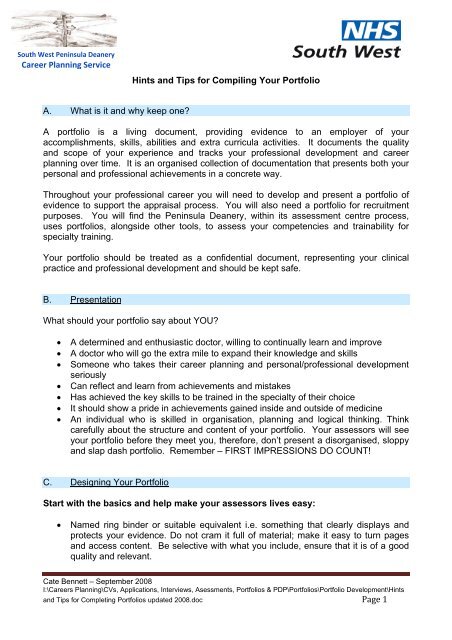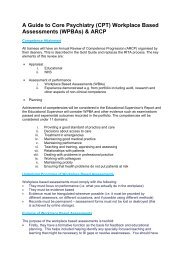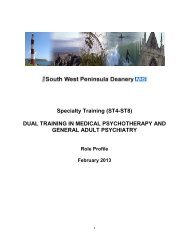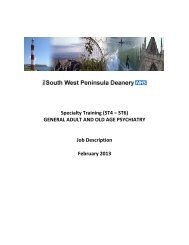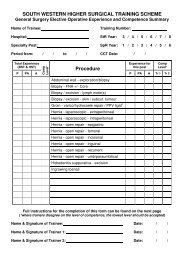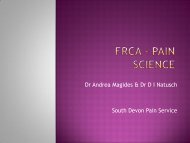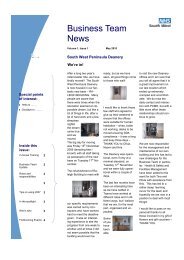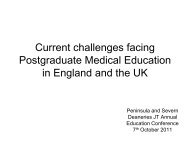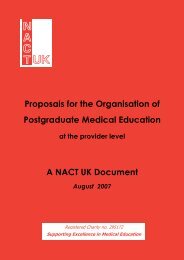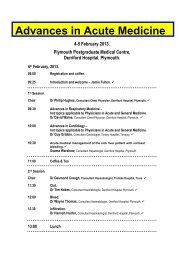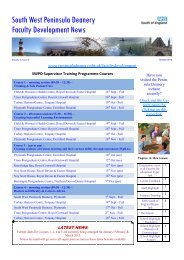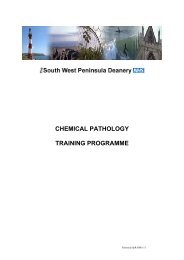Hints and Tips for Compiling Your Portfolio - South West Peninsula ...
Hints and Tips for Compiling Your Portfolio - South West Peninsula ...
Hints and Tips for Compiling Your Portfolio - South West Peninsula ...
You also want an ePaper? Increase the reach of your titles
YUMPU automatically turns print PDFs into web optimized ePapers that Google loves.
<strong>South</strong> <strong>West</strong> <strong>Peninsula</strong> Deanery<br />
Career Planning Service<br />
<strong>Hints</strong> <strong>and</strong> <strong>Tips</strong> <strong>for</strong> <strong>Compiling</strong> <strong>Your</strong> <strong>Portfolio</strong><br />
A. What is it <strong>and</strong> why keep one?<br />
A portfolio is a living document, providing evidence to an employer of your<br />
accomplishments, skills, abilities <strong>and</strong> extra curricula activities. It documents the quality<br />
<strong>and</strong> scope of your experience <strong>and</strong> tracks your professional development <strong>and</strong> career<br />
planning over time. It is an organised collection of documentation that presents both your<br />
personal <strong>and</strong> professional achievements in a concrete way.<br />
Throughout your professional career you will need to develop <strong>and</strong> present a portfolio of<br />
evidence to support the appraisal process. You will also need a portfolio <strong>for</strong> recruitment<br />
purposes. You will find the <strong>Peninsula</strong> Deanery, within its assessment centre process,<br />
uses portfolios, alongside other tools, to assess your competencies <strong>and</strong> trainability <strong>for</strong><br />
specialty training.<br />
<strong>Your</strong> portfolio should be treated as a confidential document, representing your clinical<br />
practice <strong>and</strong> professional development <strong>and</strong> should be kept safe.<br />
B. Presentation<br />
What should your portfolio say about YOU?<br />
• A determined <strong>and</strong> enthusiastic doctor, willing to continually learn <strong>and</strong> improve<br />
• A doctor who will go the extra mile to exp<strong>and</strong> their knowledge <strong>and</strong> skills<br />
• Someone who takes their career planning <strong>and</strong> personal/professional development<br />
seriously<br />
• Can reflect <strong>and</strong> learn from achievements <strong>and</strong> mistakes<br />
• Has achieved the key skills to be trained in the specialty of their choice<br />
• It should show a pride in achievements gained inside <strong>and</strong> outside of medicine<br />
• An individual who is skilled in organisation, planning <strong>and</strong> logical thinking. Think<br />
carefully about the structure <strong>and</strong> content of your portfolio. <strong>Your</strong> assessors will see<br />
your portfolio be<strong>for</strong>e they meet you, there<strong>for</strong>e, don’t present a disorganised, sloppy<br />
<strong>and</strong> slap dash portfolio. Remember – FIRST IMPRESSIONS DO COUNT!<br />
C. Designing <strong>Your</strong> <strong>Portfolio</strong><br />
Start with the basics <strong>and</strong> help make your assessors lives easy:<br />
• Named ring binder or suitable equivalent i.e. something that clearly displays <strong>and</strong><br />
protects your evidence. Do not cram it full of material; make it easy to turn pages<br />
<strong>and</strong> access content. Be selective with what you include, ensure that it is of a good<br />
quality <strong>and</strong> relevant.<br />
Cate Bennett – September 2008<br />
I:\Careers Planning\CVs, Applications, Interviews, Asessments, <strong>Portfolio</strong>s & PDP\<strong>Portfolio</strong>s\<strong>Portfolio</strong> Development\<strong>Hints</strong><br />
<strong>and</strong> <strong>Tips</strong> <strong>for</strong> Completing <strong>Portfolio</strong>s updated 2008.doc Page 1
• Make navigation simple; include a contents page at the front <strong>and</strong> ensure that you<br />
have clearly divided the various sections of your portfolio by using dividers that are<br />
wider than your A4 material. Be logical in your layout; consider the impression you<br />
will be giving about the way you potentially think <strong>and</strong> work.<br />
• CV at the front of the portfolio. You may wish to include both a summarised CV,<br />
which will provide details of your career to date in an easy to read shortened <strong>for</strong>mat,<br />
along with your full CV. Remember, your assessors only have a very limited period<br />
of time to look at your portfolio <strong>and</strong> interview you. By providing a summarised CV<br />
you will be able to quickly tell them about your education, key qualifications, audits,<br />
prizes, research <strong>and</strong> relevant work experiences. For hints <strong>and</strong> tips <strong>for</strong> compiling<br />
CVs http://www.peninsuladeanery.nhs.uk/index.php?option=com_content&task=view&id=102&Itemid=115<br />
D. Content<br />
There are a number of ways to structure your portfolio <strong>and</strong> two of the commonest are:<br />
• An exp<strong>and</strong>ed CV<br />
• Based on GMC’s Good Medical Practice Guide <strong>for</strong> Doctors<br />
You do not have to follow these structures but be sure that you can meet the criteria laid<br />
down in the guide – visit www.gmcuk.org<br />
An exp<strong>and</strong>ed CV layout might include the following sections. If you use this <strong>for</strong>mat you<br />
should also use the mapping document (below) so that you can identify which parts of your<br />
portfolio contain evidence to support good medical practice (taken from the GMC domains<br />
<strong>for</strong> Good Medical Practice.)<br />
• Personal details<br />
• Contents page<br />
• Mapping Document (to GMC Domains of Good Medical Practice)<br />
• CV<br />
• Certificates (Degrees, CRB, Completion of Foundation etc)<br />
• Self appraisal & personal development plan<br />
• Posts held<br />
• Appraisal meetings<br />
• Review <strong>for</strong>ms<br />
• Assessments of competence (If you have large numbers of work based assessment<br />
<strong>for</strong>ms then you can include them but it would be best to put them all together with a list<br />
at the front summarising the assessments & types of cases done)<br />
• Reflective practice<br />
• Teaching (with feedback)<br />
• Presentations (with feedback)<br />
• Audit<br />
• Research & Publications<br />
• IT Skills<br />
• Careers<br />
• Extra-curricula activities<br />
Cate Bennett – September 2008<br />
I:\Careers Planning\CVs, Applications, Interviews, Asessments, <strong>Portfolio</strong>s & PDP\<strong>Portfolio</strong>s\<strong>Portfolio</strong> Development\<strong>Hints</strong><br />
<strong>and</strong> <strong>Tips</strong> <strong>for</strong> Completing <strong>Portfolio</strong>s updated 2008.doc Page 2
The mapping document might look like this <strong>and</strong> allow you to demonstrate evidence linking<br />
your achievements to the GMC domains of good practice:<br />
Domain of Good Medical Practice<br />
Good Medical Care<br />
Evidence Presented<br />
Maintaining Good Medical Practice<br />
Relationships with Patients<br />
Relationships with Colleagues<br />
Teaching & Training<br />
Probity<br />
Health<br />
Cate Bennett – September 2008<br />
I:\Careers Planning\CVs, Applications, Interviews, Asessments, <strong>Portfolio</strong>s & PDP\<strong>Portfolio</strong>s\<strong>Portfolio</strong> Development\<strong>Hints</strong><br />
<strong>and</strong> <strong>Tips</strong> <strong>for</strong> Completing <strong>Portfolio</strong>s updated 2008.doc Page 3
An alternative is to organise your portfolio based on the GMC domains of good practice.<br />
This would include the following sections:<br />
GOOD MEDICAL PRACTICE<br />
1. Good Medical Care – Examples of documentation which are appropriate<br />
• Log book (try to log all procedures), Trainers reports, RITA <strong>for</strong>ms<br />
• Deanery documentation (foundation sign off <strong>for</strong>m)<br />
• Previous Personal Development Plan(s)<br />
• Audit, reflections, changes in practice documented<br />
• Complaints/outcomes/reflections<br />
• Critical incidents, reflections<br />
• Reflections on own practice<br />
• Reflections on your training <strong>and</strong> progress<br />
2. Maintaining Good Medical Practice - The purpose of this section is to record<br />
continuing educational activities undertaken since the last appraisal. Any difficulties<br />
in attending these activities should be recorded, with reasons <strong>and</strong> the action taken<br />
to address these difficulties. You should keep up to date <strong>and</strong> ensure that you<br />
acquire the necessary knowledge <strong>and</strong> skills to work appropriately as a doctor in<br />
training. You should keep yourself in<strong>for</strong>med about your working environment by<br />
keeping up to date about key directions <strong>and</strong> changes in the NHS <strong>and</strong> in medical<br />
practice. You should interest yourself in research findings <strong>and</strong> you may wish to<br />
engage in undertaking <strong>and</strong> participating in research activities.<br />
Examples of documentation you might include:<br />
• Examples of attendance at local <strong>and</strong> regional teaching sessions (keep a record<br />
of attendance at lunchtime teaching, generic skills <strong>and</strong> study days)<br />
• Certificates of attendance at courses such as ILS, ALERT, ALS<br />
• Examination results to demonstrate your professional development<br />
• Record of clinical governance activities, including audit activities <strong>and</strong> attendance<br />
at your clinical team’s meetings<br />
• Record of research activities <strong>and</strong> outcomes (e.g. publications, presentations)<br />
• Record of Study Leave/Continuing Professional Development (CPD)-usually<br />
after Foundation training<br />
3. Working relationships with colleagues - The purpose of this section is to reflect<br />
on your relationship with your colleagues.<br />
Examples of documentation, which may be appropriate, are:<br />
• For each post/placement e.g. rotating round ward etc… a description of the<br />
setting within which you work <strong>and</strong> the team structure<br />
• Four line statement of clinical setting with personal account of how you feel you<br />
are relating to, <strong>and</strong> are part of the team<br />
• Statement from consultant/tutor trainer (<strong>for</strong> Foundation years this will be the end<br />
of placement report from your clinical supervisor)<br />
• Peer review/360° (<strong>for</strong> Foundation years this is the mini-PAT)<br />
Cate Bennett – September 2008<br />
I:\Careers Planning\CVs, Applications, Interviews, Asessments, <strong>Portfolio</strong>s & PDP\<strong>Portfolio</strong>s\<strong>Portfolio</strong> Development\<strong>Hints</strong><br />
<strong>and</strong> <strong>Tips</strong> <strong>for</strong> Completing <strong>Portfolio</strong>s updated 2008.doc Page 4
4. Relations with patients - The purpose of this section is to reflect on your<br />
relationships with your patients<br />
Examples of documentation, which may be appropriate, are:<br />
• Personal statement<br />
• Statements from Trainers/Tutors/Consultants/Work Colleagues<br />
• Patient questionnaires/reviews<br />
• Thank you letters<br />
• Complaints with outcomes<br />
5. Teaching <strong>and</strong> Training - The purpose of this section is to reflect on your teaching<br />
<strong>and</strong> training activities since your last appraisal <strong>and</strong> should be recorded.<br />
Examples of documentation, which may be appropriate, are:<br />
• Record of Teaching Activity<br />
• Teaching activities to other doctors/students/Professions allied to Medicine<br />
• Include feedback where appropriate or available<br />
• Include teaching – Courses – Small groups 1-to-1<br />
• Training in Teaching (e.g. Training the Trainers) should be included in (2)<br />
6. Research<br />
• Evidence of <strong>for</strong>mal research commitments.<br />
• Record of any research ongoing or completed in the previous year.<br />
• Record of funding arrangements <strong>for</strong> research.<br />
• Record of noteworthy achievements.<br />
• Confirmation that appropriate ethical approval has been secured <strong>for</strong> all research<br />
undertaken.<br />
• Publications<br />
It is important that you also include reflective pieces of work that show your ability to learn<br />
from experiences, both good <strong>and</strong> bad, <strong>and</strong> that you are proactive in improving your<br />
knowledge, skills <strong>and</strong> professional development.<br />
The exp<strong>and</strong>ed CV style may prove easier to navigate especially during the assessment<br />
process, whilst the GMC style portfolio reflects that currently required of consultants.<br />
When compiling your portfolio you should also:<br />
• Get ideas from your educational supervisor.<br />
• Ensure you have the relevant portfolio documentation required by each<br />
Deanery you apply to <strong>for</strong> specialty training. For details of the <strong>Peninsula</strong><br />
Deanery’s requirements visit the specialty training pages:<br />
www.peninsuladeanery.nhs.uk<br />
• Check with the relevant Royal College <strong>for</strong> any additional evidence that will<br />
help support your application to a particular specialty.<br />
Cate Bennett – September 2008<br />
I:\Careers Planning\CVs, Applications, Interviews, Asessments, <strong>Portfolio</strong>s & PDP\<strong>Portfolio</strong>s\<strong>Portfolio</strong> Development\<strong>Hints</strong><br />
<strong>and</strong> <strong>Tips</strong> <strong>for</strong> Completing <strong>Portfolio</strong>s updated 2008.doc Page 5
E. Articulating <strong>Your</strong> <strong>Portfolio</strong> at Assessment Centres<br />
Prior to attending assessment centres, ensure that you take time to prepare <strong>for</strong> each<br />
station. Consider the following when preparing <strong>for</strong> the portfolio station:<br />
• What does this portfolio say about me?<br />
• What key skills <strong>and</strong> experiences does it highlight?<br />
• What was the purposing of developing it?<br />
• How has it helped me improve my professional per<strong>for</strong>mance, skills, knowledge <strong>and</strong><br />
interest?<br />
You must know your portfolio inside out <strong>and</strong> back to front as you don’t know what<br />
questions you will be asked. Be <strong>for</strong>thcoming when you’re being interviewed, convince<br />
your interviewers that you’ve done everything you can to prepare yourself <strong>for</strong> training in<br />
their specialty <strong>and</strong> that you are committed <strong>and</strong> enthusiastic.<br />
Ensure that you have re-read the relevant person specifications <strong>and</strong> job descriptions so<br />
that you are fully aware of the types of things you may be assessed against.<br />
Remember, your portfolio is a living document; it should help chart your development <strong>and</strong><br />
provide evidence of the level of your competencies <strong>and</strong> enthusiasm <strong>for</strong> the specialty you<br />
are applying to.<br />
<strong>Your</strong> interviewers want to be convinced that you are trainable <strong>and</strong> have the potential to<br />
per<strong>for</strong>m well in their specialty.<br />
DO NOT take your portfolio lightly!<br />
Thanks to Drs Cate Powell, Melanie Huddart <strong>and</strong> Alison Carr.<br />
Cate Bennett – September 2008<br />
I:\Careers Planning\CVs, Applications, Interviews, Asessments, <strong>Portfolio</strong>s & PDP\<strong>Portfolio</strong>s\<strong>Portfolio</strong> Development\<strong>Hints</strong><br />
<strong>and</strong> <strong>Tips</strong> <strong>for</strong> Completing <strong>Portfolio</strong>s updated 2008.doc Page 6


